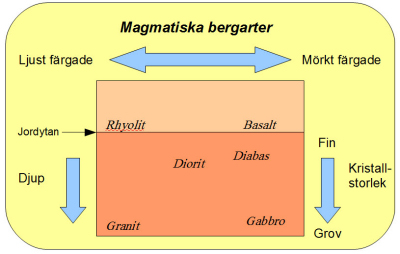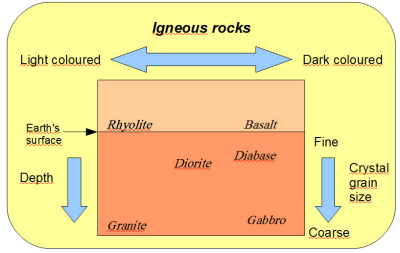Diabase Earthcache EarthCache
-
Difficulty:
-

-
Terrain:
-

Size:  (not chosen)
(not chosen)
Please note Use of geocaching.com services is subject to the terms and conditions
in our disclaimer.

[Sve] Hägghults diabasbrott
"Svart granit" - diabas
Svart granit är inte en granit enligt geologiska klassifikationer. Vetenskapligt heter stenen DIABAS och består huvudsakligen av plagioklas och pyroxen, Liksom basalt och granit har diabas bildats av magma från jordens inre. Den har dock inte stelnat i stora magmakammare eller på jordytan utan i smala gångar eller sprickor på väg upp mot jordytan. Avsvalningen har varit snabb vilket medför att diabasen har mindre mineralkorn än t ex granit och gabbro. Den svarta färgen orsakas av att plagioklaskornen innehåller stora mängder korn av järnmineral. Diabas är en relativt vanlig bergart men sällan är den så svart som i Hägghult. En liknande bergart är basalt, men denna är oftast mer gråaktig.

Olikheter i magmatiska bergarter
Geografi och geologi
Skåne genomkorsas från sydöst till nordväst av den s k Tornqvistzonen. Med sina förkastningar delas landskapet upp i två geologiska delar. Den norra delen av landskapet består av graniturberg och i söder återfinns sedimentära bergarter från såväl kambrosilurtiden som trias, jura och tertiär. Tornqvistzonen är en serie förkastningar som sträcker sig från den rumänska Svartahavskusten till Nordsjön. I Skåne markerar den gränsen mellan den östeuropeiska plattan och den Baltiska skölden där denna gränsar till ett stort sänkningsområde i västra delen av kontinentala Europa. I Sverige är zonen ca 50 km bred och har genom ett antal förkastningar gett upphov till de skånska åsarna Hallandsåsen, Nävlingeåsen, Kullaberg, Linderödsåsen, Romeleåsen och Söderåsen..
Diabasgångarna i nordöstra Skåne har daterats radiografiskt och vissa är så gamla som 1,2 miljarder år, andra 900 miljoner år. Eftersom basalt, syenit och diabas endast bildas då det är rörelse i jordskorpan ger det anledning att ställa frågan - vad hände egentligen i Skåne för en miljard år sedan? En tolkning är att dessa bergarter bildats i samband med plattektoniska processer, dvs en begynnande kontinentaldrift som snart övergick i en kollision.
Praktiska applikationer
Diabas är ett hårt och styvt material med stor tålighet mot nötning och kemikalier. Det är korrosionståligt, leder inte elektricitet och är inte magnetiskt. Diabas har dessutom låg vattenabsorption och värmeutvidgning. Hårdheten i Mohs skala är 5,8. De huvudsakliga användningsområdena för diabas är dekorativa eller baserade på dess fysiska egenskaper. Skulpturer, monument och byggnadsdekorationer är typiska användningsområden. Raoul Wallenbergsmonumentet utanför FN-huset i New York, Empire State Building och US Marine Corps Memorial i Washington DC har alla inslag av diabas. Det senare består av diabas från Hägghult i den övre, "steniga" delen av foten. Andra typiska användningsområden är bänkskivor, och gravstenar. Även isoleringsmaterial i form av stenull (Rockwool) tillverkas av smält diabas. Under den neolitiska perioden tillverkades också stenyxor av diabas.

US Marine Corps Memorial, Washington DC
För att logga måste du maila cacheägaren svaren på följande tre frågor:
1. Utanför kaféet står några stenstatyer i ring. Hur många statyer är det? OBS. Egentligen måste man betala inträde för att komma hit, men berätta för personalen på kaféet att du bara vill ta ett foto så är det nog OK
2. Målat på en sten vid parkeringen hittar du densiteten på Hägghultsdiabasen. Vilket är talet (alla 4 siffrorna måste vara rätt)?
3. Bedöm bredden på det vattenfyllda stenbrottet i höjd med kaféet
Extra. Ta ett foto av dig själv tillsammans med stenstatyerna i fråga 1 - visa bara inte hur många de är (inget krav för loggning)
Du behöver inte vänta på svar från cacheägaren innan du loggar. Dock kommer loggar som inte åtföljs av ett svar inom en vecka att raderas.
Lycka till!
[Eng] The diabase quarry of Haegghult
"Black granite" - diabase
According to geological classification black granite is not a granite at all. Scientifically its name is DIABASE and consists mainly of plagioclase crystals in a finer base of pyroxene, Just like basalt and granite, diabase was formed from magma rising from the earths core. However it did not solidify in huge magma chambers or at the surface of the Earth but in narrow shafts or cracks on its way towards the surface. The molten rock was cooled rapidly which is the reason for its grains being finer than those in for example granite or gabbro. The black colour is caused by the high content of iron minerals in the plagioclase grains. Diabase is a relatively common rock but it is rarely as black as the one in Haegghult. A similar rock is basalt which however is more greyish to the eye.

Differences of igneous rocks
Geography and geology
Scania is from the southeast to the northwest diagonally transversed by the so called Tornqvist zone. With its faults the region of Scania is divided into two separate regions. The northern part of the region consists of primary rock granites while the south consists of sedimentary rock from the Cambro-Silurian era as well as from Trias, Jura and the Tertiary period. The Tornqvist zone is a series of faults, stretching from the Romanian Black Sea coast to the North Sea. In Scania it marks the borderline between the East European and the Baltic plates where the latter borders a large low-lying area in the western part of continental Europe. In Sweden the zone is about 50 km wide and has through a series of faults created the Scanian ridges Halland Ridge, Naevlinge Ridge, Kullaberg, Linderoed Ridge, Romele Ridge and Soeder Ridge.
The diabase dikes and sills of northeastern Scania has been radiographically dated and some are as old as 1.2 billion years, others 900 million years old. Since basalt, syenite and diabase are only formed in connection to movements in the Earths’ crust a question arises – what happened in Scania a billion years ago? One interpretation is that these rocks were formed during plate tectonic processes, i.e. a beginning of a continental drift that soon turned into a collision.
Practical applications
Diabase is a hard and rigid material with great durability against abrasion and chemical influence. It resists corrosion, does not conduct electricity and is non magnetic. Diabase also has a low moist absorption and thermal expansion. Its hardness is 5.8 in the Mohs scale. Main uses for diabase are decorative or based on its physical properties. Sculptures, monuments and building decorations are typical appliances. The Raoul Wallenberg monument outside the UN building in New York, the Empire State Building and the US Marine Corps monument in Washington DC all have elements of diabase in them. The latter consists of diabase from Haegghult in the rocky upper part of the base. Other typical uses are countertops and gravestones. Even insulation in the form of mineral wool (Rockwool) is made from molten diabase. During the neolithic period stone axes were sometimes made from diabase.

US Marine Corps Memorial, Washington DC
To qualify for logging you have to mail the cache owner the answers to the following three questions:
1. Outside the café you will find some stone statues in a circle. How many statues are there? Note: There IS a charge to enter here, but ask the cafe staff for permission to take a photo and it ought to be OK
2. Painted on a rock at the car park is the density of the Haegghult diabase. What is the number painted (all four numbers have to be correct)?
3. Approximate the width of the water filled quarry adjacent to the café.
Extra. Take a photo of yourself together with the statues in question 1 - just make sure not to show their number (not needed to qualify for logging)
You don't have to wait for an answer from the cache owner to log. Logs not followed by an answer to the questions within a week will however be deleted.
Good luck
 The most exciting way to learn about the Earth and its processes is to get into the outdoors and experience it first-hand. Visiting an Earthcache is a great outdoor activity the whole family can enjoy. An Earthcache is a special place that people can visit to learn about a unique geoscience feature or aspect of our Earth. Earthcaches include a set of educational notes and the details about where to find the location (latitude and longitude). Visitors to Earthcaches can see how our planet has been shaped by geological processes, how we manage the resources and how scientists gather evidence to learn about the Earth. To find out more click HERE.
The most exciting way to learn about the Earth and its processes is to get into the outdoors and experience it first-hand. Visiting an Earthcache is a great outdoor activity the whole family can enjoy. An Earthcache is a special place that people can visit to learn about a unique geoscience feature or aspect of our Earth. Earthcaches include a set of educational notes and the details about where to find the location (latitude and longitude). Visitors to Earthcaches can see how our planet has been shaped by geological processes, how we manage the resources and how scientists gather evidence to learn about the Earth. To find out more click HERE.

Additional Hints
(No hints available.)